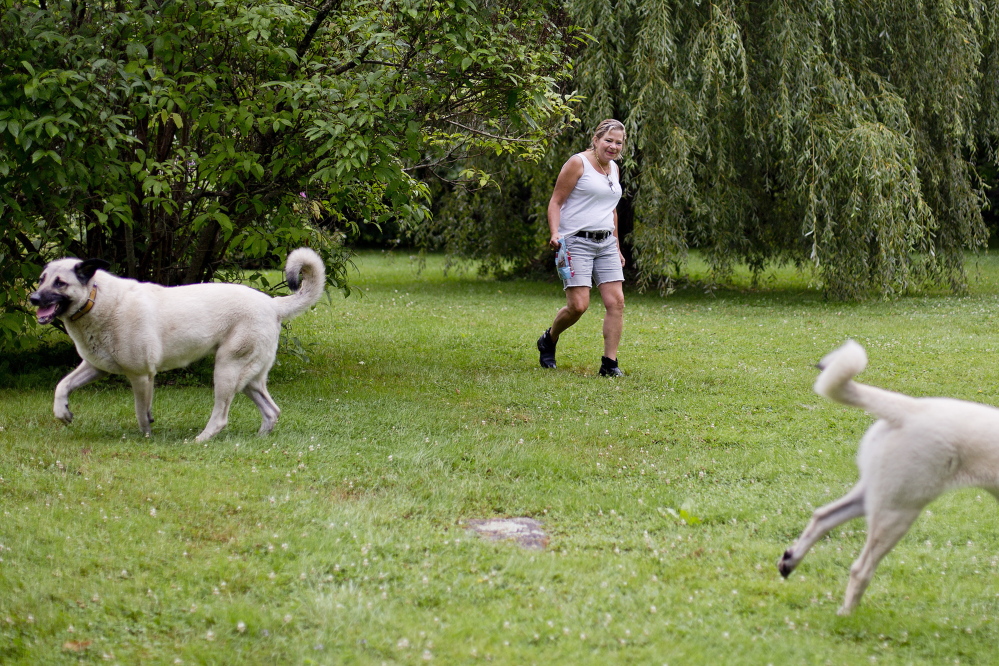One of Meet’s former subjects, wildlife biologist Geri Vistein, introduced us to the concept of guardian dogs – big dogs who are used on farms to protect livestock from predators – and now we’re a little obsessed. Thus, we went in search of a breeder in Maine raising these dogs, which was harder than we expected. They are complicated creatures and they tend to be quite large. One breeder we talked to had just neutered her male because two big dogs and a litter of 10 was just a bit much. Another was about to retire her bitch. Then we found Mary Hughes, who is preparing to breed the older of her two Kangal females. We called her up to talk about the joys of raising guardian dogs and the history behind her particular breed.
Hughes will join Vistein at Two Coves Farm in Harpswell on Wednesday for a talk on ways farmers can work with guardian dogs to protect their livestock while also sharing their landscapes with carnivores like hawks, eagles, coyotes, bears and cougars. (Two Coves farmers Joe and Laura Grady work successfully with a guardian dog, Tess, and will share their experience, too). The event, at 90 Neils Point Road, runs from 5 to 8 p.m. and will include a potluck. For more information contact Vistein: gvistein@coyotelivesinmaine.com.
FRIENDS OF THE FLOCK: Hughes is not actually a farmer, although she is a “very serious gardener” and her guardian dogs do keep an eye on her flock of 12 chickens. “I’ve never lost a chicken.” She said the dogs can scare off hawks and take out a fisher cat if need be. Hughes’ day job is as a goldsmith (her jewelry is as beautiful as her dogs), but she has a passion for this ancient breed, which she said goes back 8,000 years and has its roots in Turkey. She’s been interested in guardian dogs for about 25 years, and she’s been doing rescues nationwide for nearly that long. The farthest she’s ever gone to rescue a dog is Seattle (she found it a home out there). At one point she had four guardian dogs in her home, including one she’d rescued who wasn’t expected to live past six months but lived another four years. “She didn’t get along with anyone,” except Hughes herself. “It made my life very complicated.” Hughes is down to two dogs now, Hediye and Filiz, who weigh in at 107 and 110 pounds. They are Kangal dogs, who look like mastiffs and are fawn-colored.
BLOODLINES: Although she’s preparing to breed Filiz, her 5-year-old, Hughes doesn’t call herself a breeder per se. “I’m really more of a conservationist,” she said. “My view of the dogs is really sort of global.” Meaning she’s very aware of what’s happening with Kangal dogs around the world (she has photographs of her dogs’ grandparents). Kangals are just one of several breeds that are being used as guardian dogs on American farms, but they are, to her mind, the finest of them all. And rare. Which means that the breed is in jeopardy of being inbred if owners aren’t careful. Her own dogs came from Holland. When she breeds one of them this winter, she may import sperm from Germany to do so. Or Michigan.
WHO’S YOUR DADDY: That’s a long way, either way. “There are no eligible bachelors,” Hughes said. “There are approximately 800 of them in the United States. That is part of the reason this conservation is so important.”
NOBILITY: “They claim these dogs are never really owned and that you are more of a steward to them. That’s what I consider myself to be. I am the caretaker of a very noble creature.”
WORKING GIRLS: One reason that Hughes has been kept busy rescuing Kangals and what is known as Anatolian shepherds (she believes that’s actually a catchphrase for guardian dogs of mixed breeds) is that they aren’t exactly pets. “They are always guarding. That is the only thing they are truly predisposed to do. It is really important that people be able to handle them.” And put them to work. “The more that is expected of them in their world, the more the dog is able to mature.” Kangals are “deep thinkers” but require extensive training as puppies. But positive training: “They don’t do well being yelled at.” Without a role, the dogs won’t be happy. “They can be extremely problematic,” she said. “They have minds like steel traps. They remember everything.”
WANDERERS: Kangals and other guardian dogs have a tendency to wander. “They require fencing,” she said. “And a physical electric fence, not just a wire. They all wander because they are essentially determining what the defining perimeters are.” The reality is that a lot of these dogs shouldn’t go to a lot of homes, she said. They belong on farms, where they can have a clear role and help the farmer keep the livestock safe. When she does have puppies ready to be adopted, she said, “I would like to place the dogs as much as I can with working people.” Even though saying goodbye won’t be easy: “I can’t afford to end up with a whole lot of puppies myself, although I know that will be a challenge for me, giving them up.” Because she believes so much in this breed, she said she’ll feel good about sending Filiz’s pups out into the farms of America. “To me that is really giving back and also really paying it forward.”
Send questions/comments to the editors.




Comments are no longer available on this story